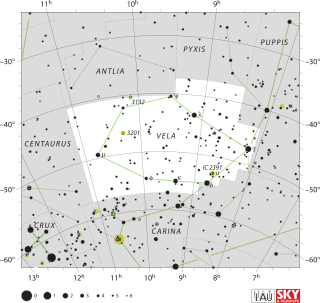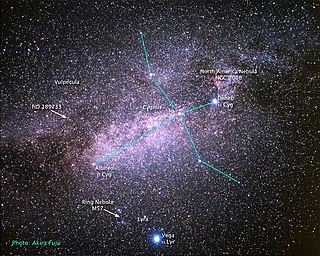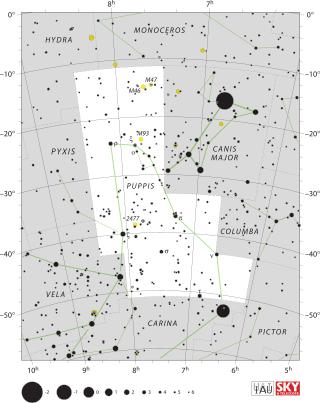Related Research Articles

Vela is a constellation in the southern sky, which contains the Vela Supercluster. Its name is Latin for the sails of a ship, and it was originally part of a larger constellation, the ship Argo Navis, which was later divided into three parts, the others being Carina and Puppis. With an apparent magnitude of 1.8, its brightest star is the hot blue multiple star Gamma Velorum, one component of which is the brightest Wolf-Rayet star in the sky. Delta and Kappa Velorum, together with Epsilon and Iota Carinae, form the asterism known as the False Cross. 1.95-magnitude Delta is actually a triple or quintuple star system.

A binary star or binary star system is a system of two stars that are gravitationally bound to and in orbit around each other. Binary stars in the night sky that are seen as a single object to the naked eye are often resolved using a telescope as separate stars, in which case they are called visual binaries. Many visual binaries have long orbital periods of several centuries or millennia and therefore have orbits which are uncertain or poorly known. They may also be detected by indirect techniques, such as spectroscopy or astrometry. If a binary star happens to orbit in a plane along our line of sight, its components will eclipse and transit each other; these pairs are called eclipsing binaries, or, together with other binaries that change brightness as they orbit, photometric binaries.
HD 188753 is a hierarchical triple star system approximately 151 light-years away in the constellation of Cygnus, the Swan. In 2005, an extrasolar planet was announced to be orbiting the primary star in the system. Follow-up measurements by an independent group in 2007 did not confirm the planet's existence.

HD 189733, also catalogued as V452 Vulpeculae, is a binary star system approximately 64.5 light-years away in the constellation of Vulpecula. The primary star is suspected to be an orange dwarf star, while the secondary star is a red dwarf star. Given that this system has the same visual magnitude as HD 209458, it promises much for the study of close transiting extrasolar planets. The star can be found with binoculars 0.3 degrees east of the Dumbbell Nebula (M27).
HD 38529 is a binary star approximately 138 light-years away in the constellation of Orion.

HD 10307 is a spectroscopic binary star in the constellation Andromeda. The primary is similar to the Sun in mass, temperature and metal content. situated about 42 light-years from Earth Its companion, HR 483 B, is a little-studied red dwarf.
HD 59686 is a binary star system in the northern constellation of Gemini. It is visible to the naked eye as a dim point of light with an apparent visual magnitude of +5.45. The distance to this system is approximately 292 light years based on parallax, but it is drifting closer with a radial velocity of −34 km/s.
HD 156846 is a binary star system in the equatorial constellation of Ophiuchus, positioned a degree SSE of Messier 9. It has a yellow hue and is just barely bright enough to be visible to the naked eye with an apparent visual magnitude of 6.5. The system is located at a distance of 156 light years from the Sun based on parallax. It is drifting closer with a radial velocity of −68.5 km/s, and is predicted to come to within 85.0 light-years in about 476,000 years.
HD 41004 is a visual binary star system in the southern constellation of Pictor. It is too faint to be visible to the naked eye, having a combined apparent visual magnitude of 8.65. The two components have a magnitude difference of 3.7, and share a common proper motion with an angular separation of 0.30″, as of 2018. The distance to this system is approximately 136 light years based on parallax. It is drifting further away from the Sun with a radial velocity of +42.5 km/s, having come to within 44.5 ly some 831,000 years ago.
HD 109749 is a binary star about 206 light years away in the constellation of Centaurus.
HD 118203 is a star located in the northern circumpolar constellation of Ursa Major. It has the proper name Liesma, which means flame, and it is the name of a character from the Latvian poem Staburags un Liesma. The name was selected in the NameExoWorlds campaign by Latvia, during the 100th anniversary of the IAU.
HD 8673 is a binary star in the northern constellation of Andromeda. It has an apparent magnitude and absolute magnitude of 6.34 and 3.56 respectively. Based upon an annual parallax shift of 26.2 mas, the system is located around 124.5 light years away. The system is moving further from the Earth with a heliocentric radial velocity of +19 km/s. A sub-stellar companion was detected in 2005; it could either be an exoplanet or a brown dwarf.

Beta Leonis Minoris, Latinized from β Leonis Minoris, is a binary star in the constellation of Leo Minor. It has an overall apparent visual magnitude of approximately 4.2. Although it is the only star in Leo Minor with a Bayer designation, it is only the second brightest star in the constellation.

Transiting Exoplanet Survey Satellite is a space telescope for NASA's Explorer program, designed to search for exoplanets using the transit method in an area 400 times larger than that covered by the Kepler mission. It was launched on 18 April 2018, atop a Falcon 9 launch vehicle and was placed into a highly elliptical 13.70-day orbit around the Earth. The first light image from TESS was taken on 7 August 2018, and released publicly on 17 September 2018.
HD 28254 is an 8th magnitude G-type main sequence star located 180 light years away in the constellation Dorado. This star is larger, cooler, brighter, and more massive than the Sun, and its metal content is 2.3 times as much as the Sun. In 2009, a gas giant planet was found in orbit around the star.
Kepler-14 is a binary star system targeted by the Kepler spacecraft. It is host to one known planet: the Jupiter-like Kepler-14b. The star system was identified by Kepler as a possible planetary host, but when imaging revealed that Kepler-14 was a binary star system and not a single star, the confirmation process became protracted. The stars are separated by at least 280 AU, and the stars complete an orbit around a common center of mass every 2800 years. Both stars are larger than the Sun. They are of similar absolute magnitudes; however, the primary star is brighter as seen from Earth.

HD 53705/53706/53680 is a star system that lies approximately 54 light-years away in the constellation of Puppis. The system consists of four stars in two binaries, making it one of the nearest quadruple star systems.

Spectro-Polarimetric High-contrast Exoplanet REsearch (VLT-SPHERE) is an adaptive optics system and coronagraphic facility at the Very Large Telescope (VLT). It provides direct imaging as well as spectroscopic and polarimetric characterization of exoplanet systems. The instrument operates in the visible and near infrared, achieving, albeit over a limited field of view, superior image quality and contrast for bright targets.

MASCARA is an exoplanet experiment by Leiden University. It has two stations, one in each hemisphere, each of which use cameras to make short exposure photographs of most of the visible sky to observe stars to a magnitude of 8.4. The Northern Hemisphere station at Roque de los Muchachos Observatory, La Palma, started observations in February 2015. The Southern Hemisphere station at La Silla Observatory, Chile, saw first light in July 2017.
HD 85628 Ab, also designed MASCARA-4b, is an exoplanet located approximately 559.47±3.05 light years from Earth. This planet was discovered in 2019 using the transit method.
References
- ↑ Wang, Songhu; et al. (October 5, 2018). "HD 202772 Ab: A Transiting Hot Jupiter Around A Bright, Mildly Evolved Star In A Visual Binary Discovered By Tess". The Astronomical Journal. 157 (2): 51. arXiv: 1810.02341 . doi: 10.3847/1538-3881/aaf1b7 . S2CID 59499230.